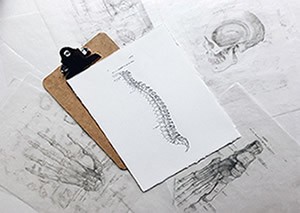 Hello and welcome to this week’s blog, all about having a healthy back.
Hello and welcome to this week’s blog, all about having a healthy back.
First, a little anatomy, so you can understand why it is not a cut and dried issue when it comes to your back.
There are 33 bones in your spine with 140 overlapping and interconnected muscles enabling it to function correctly.
173 pieces of anatomy in the back alone. That is a lot of things to take into consideration when something is not quite right with your back. That puts it into perspective that there could be more than meets the eye to your back issues.
Then there are the other muscles and structures nearby, all of which, from your toes right up to your head, which could be having a knock-on effect to your back.
There are three long muscles which run along the length of your spine, the multifidus, the semispinalis, and the rotatores. Collectively, they are known as the erector spinae group because they stabilise your spine during movement.
Your whole back is incredibly strong, flexible, and complicated, and nearly everyone will experience an issue with their back at least once in their lives. It is not, in most cases, permanent or repetitive. Nor does it mean you have a ‘weak back’ and need to avoid certain activities to keep it safe.
It takes a lot to do your back genuine damage, even if you regularly ‘put it out’ and have had periods of time spent being careful with it. If you are not sure of what is occurring, seek your doctor’s advice in the first instance.
Your Back is Hurting
The absolute best thing you can do right now is to MOVE. Carefully, gently, but yes, move and keep moving. The last thing you want is your muscles freezing into a tightened or distressed state.
Last year I put my back out during a weighted squat, I felt my form broke and knew with instantly that I was about to experience something with my back. I re-racked the barbell and could barely stand up straight, I was hurting like hell. I knew how to help myself and put my own advice into action.
About seven hours after the event, I was moving normally again with the stretching and rolling work I did in the specific area it was needed… which incidentally was not my back, even thought that was where I could feel it. Two days later after careful continual movement along with rest at night and stretching when appropriate, I was moving completely normally with no residual effects of the incident to be felt.
It is not usually appropriate to visit a Sports Massage Therapist in the immediate aftermath of an event like that, but certainly seek advice and book in for 3-5 days after the event to help it heal and help prevent future events.
Remember that in the first instance, as long as it is not a medical emergency*, movement is your friend.
*medical emergency constitutes when you require paramedics to assist you after your event. AND if you lose control of your bowels, have difficulty passing urine, have leg weakness and/or numbness between your legs, loss of sexual sensation/function, then you need to dial 111 immediately and explain your symptoms and await further advice.
Healthy Back Practices
Movement. Exercise. Strength Training. Flexibility Work. Movement. Healthy Sleep Position. Good Shoes. Movement. Supportive Chair. Hydration. Movement.
There really is not a lot more to it than that.
Your back needs to be challenged to become strong, to stay strong and therefore be healthy.
Movement must be in all planes that the back is capable, including your arms lifting above your head and out to the sides, and your legs moving in every way possible, and folding yourself in half to touch your toes.
Yoga and Pilates will cover all of these options, but a combination of weightlifting, swimming, walking and other sports will do the same if you do not particularly get on with either of those.
Choose something to do, build up to it gradually within your current means, and feel the benefits almost straight away.
Not sure what to do or where to start? Don’t know what you are capable of right now? Please do get in touch.
See you soon,
Chloe

